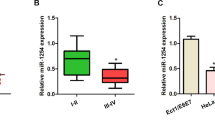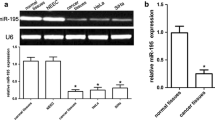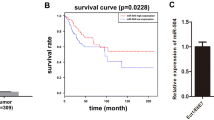Abstract
Purpose
The GEO database and KEGG database-based analyses identified the differential expression of cyclin-dependent kinase 1 (CDK1) in cervical cancer and its involvement in the cell cycle pathway. In the present study, we aim to clarify the role of CDK1 in cervical cancer and the function of upstream microRNA (miR)-143-3p/miR-495-3p.
Methods
The expression of miR-143-3p, miR-495-3p, and CDK1 in cervical cancer tissues and cells was determined using RT-qPCR. Cell bioactivities were examined by CCK-8 and flow cytometry. The binding affinity between CDK1 and miR-143-3p/miR-495-3p was investigated using dual luciferase gene reporter assay. A xenograft mouse model of cervical cancer was then established to explore their effect on the tumorigenicity of cervical cancer cells in vivo.
Results
CDK1 was found to be the common target gene of miR-143-3p and miR-495-3p. CDK1 overexpression occurred in cervical cancer tissues and cells, while expression of miR-495-3p and miR-143-3p was down-regulated. The viability was inhibited while the apoptosis was promoted in cervical cancer cells in response to miR-143-3p or miR-495-3p overexpression, or CDK1 silencing. Further, miR-143-3p or miR-495-3p overexpression was also substantiated to inhibit the tumorigenicity of cervical cancer cells in vivo, while CDK1 overexpression counteracted their effect.
Conclusion
Taken together, miR-143-3p and miR-495-3p co-target CDK1, thereby inhibiting the occurrence and development of cervical cancer.








Similar content being viewed by others
References
Dai Y, Xie F, Chen Y. Reduced levels of miR-485-5p in HPV-infected cervical cancer promote cell proliferation and enhance invasion ability. FEBS Open Bio. 2020;10(7):1348–61. https://doi.org/10.1002/2211-5463.12869.
Diouf D, Diop G, Diarra CAT, Ngom AI, Niane K, Ndiaye M, et al. Systematic screening for cervical cancer in Dakar region: prevalence and correlation with biological and socio-demographic parameters. Infect Agent Cancer. 2020. https://doi.org/10.1186/s13027-020-00290-y.
Liu J, Shi Y, Wang L, Wang J, Fan D, Han S, et al. Epidemiology and persistence of cervical human papillomavirus infection among outpatient women in Heilongjiang province: A retrospective cohort study. J Med Virol. 2020. https://doi.org/10.1002/jmv.25899.
Li J, Zhou C, Zhou H, Bao T, Gao T, Jiang X, et al. The association between methylated CDKN2A and cervical carcinogenesis, and its diagnostic value in cervical cancer: a meta-analysis. Ther Clin Risk Manag. 2016. https://doi.org/10.2147/TCRM.S108094.
Yadav N, Parveen S, Banerjee M. Potential of nano-phytochemicals in cervical cancer therapy. Clin Chim Acta. 2020. https://doi.org/10.1016/j.cca.2020.01.035.
Ma D, Zhang YY, Guo YL, Li ZJ, Geng L. Profiling of microRNA-mRNA reveals roles of microRNAs in cervical cancer. Chin Med J (Engl). 2012;125(23):4270–6.
Williams AE, Moschos SA, Perry MM, Barnes PJ, Lindsay MA. Maternally imprinted microRNAs are differentially expressed during mouse and human lung development. Dev Dyn. 2007;236(2):572–80. https://doi.org/10.1002/dvdy.21047.
Eun JW, Kim HS, Shen Q, Yang HD, Kim SY, Yoon JH, et al. MicroRNA-495-3p functions as a tumor suppressor by regulating multiple epigenetic modifiers in gastric carcinogenesis. J Pathol. 2018;244(1):107–19. https://doi.org/10.1002/path.4994.
Zhao G, Zhang L, Qian D, Sun Y, Liu W. miR-495–3p inhibits the cell proliferation, invasion and migration of osteosarcoma by targeting C1q/TNF-related protein 3. Onco Targets Ther. 2019. https://doi.org/10.2147/OTT.S193937.
Gang X, Yuan M, Zhang J. Long Non-Coding RNA TMPO-AS1 Promotes cervical cancer cell proliferation, migration, and invasion by regulating miR-143–3p/ZEB1 axis. Cancer Manag Res. 2020;12:1587–99. https://doi.org/10.2147/CMAR.S226409.
Liu M, Jia J, Wang X, Liu Y, Wang C, Fan R. Long non-coding RNA HOTAIR promotes cervical cancer progression through regulating BCL2 via targeting miR-143-3p. Cancer Biol Ther. 2018;19(5):391–9. https://doi.org/10.1080/15384047.2018.1423921.
Diril MK, Ratnacaram CK, Padmakumar VC, Du T, Wasser M, Coppola V, et al. Cyclin-dependent kinase 1 (Cdk1) is essential for cell division and suppression of DNA re-replication but not for liver regeneration. Proc Natl Acad Sci USA. 2012;109(10):3826–31. https://doi.org/10.1073/pnas.1115201109.
Deng YR, Chen XJ, Chen W, Wu LF, Jiang HP, Lin D, et al. Sp1 contributes to radioresistance of cervical cancer through targeting G2/M cell cycle checkpoint CDK1. Cancer Manag Res. 2019;11:5835–44. https://doi.org/10.2147/CMAR.S200907.
Li L, Thakur K, Cao YY, Liao BY, Zhang JG, Wei ZJ. Anticancerous potential of polysaccharides sequentially extracted from Polygonatum cyrtonema Hua in human cervical cancer hela cells. Int J Biol Macromol. 2020;148:843–50. https://doi.org/10.1016/j.ijbiomac.2020.01.223.
Huang C, Huang J, Ma P, Yu G. microRNA-143 acts as a suppressor of hemangioma growth by targeting Bcl-2. Gene. 2017;628:211–7. https://doi.org/10.1016/j.gene.2017.07.046.
He Z, Dang J, Song A, Cui X, Ma Z, Zhang Z. NEAT1 promotes colon cancer progression through sponging miR-495-3p and activating CDK6 in vitro and in vivo. J Cell Physiol. 2019;234(11):19582–91. https://doi.org/10.1002/jcp.28557.
Han B, Zhang Y, Zhang Y, Bai Y, Chen X, Huang R, et al. Novel insight into circular RNA HECTD1 in astrocyte activation via autophagy by targeting MIR142-TIPARP: implications for cerebral ischemic stroke. Autophagy. 2018;14(7):1164–84. https://doi.org/10.1080/15548627.2018.1458173.
Luo Y, Wu Y, Peng Y, Liu X, Bie J, Li S. Systematic analysis to identify a key role of CDK1 in mediating gene interaction networks in cervical cancer development. Ir J Med Sci. 2016;185(1):231–9. https://doi.org/10.1007/s11845-015-1283-8.
Chen YF, Cho JJ, Huang TH, Tseng CN, Huang EY, Cho CL. Downregulation of a novel human gene, ROGDI, increases radiosensitivity in cervical cancer cells. Cancer Biol Ther. 2016;17(10):1070–8. https://doi.org/10.1080/15384047.2016.1219818.
Song L, Wang L, Pan X, Yang C. lncRNA OIP5-AS1 targets ROCK1 to promote cell proliferation and inhibit cell apoptosis through a mechanism involving miR-143-3p in cervical cancer. Braz J Med Biol Res. 2020;53(1):e8883. https://doi.org/10.1590/1414-431X20198883.
Yang J, Jiang B, Hai J, Duan S, Dong X, Chen C. Long noncoding RNA opa-interacting protein 5 antisense transcript 1 promotes proliferation and invasion through elevating integrin alpha6 expression by sponging miR-143-3p in cervical cancer. J Cell Biochem. 2019;120(1):907–16. https://doi.org/10.1002/jcb.27454.
Cui N, Liu J, Xia H, Xu D. LncRNA SNHG20 contributes to cell proliferation and invasion by upregulating ZFX expression sponging miR-495-3p in gastric cancer. J Cell Biochem. 2019;120(3):3114–23. https://doi.org/10.1002/jcb.27539.
Chen SM, Chen HC, Chen SJ, Huang CY, Chen PY, Wu TW, et al. MicroRNA-495 inhibits proliferation of glioblastoma multiforme cells by downregulating cyclin-dependent kinase 6. World J Surg Oncol. 2013;11:87. https://doi.org/10.1186/1477-7819-11-87.
Cheng W, Yan K, Xie LY, Chen F, Yu HC, Huang YX, et al. MiR-143–3p controls TGF-beta1-induced cell proliferation and extracellular matrix production in airway smooth muscle via negative regulation of the nuclear factor of activated T cells 1. Mol Immunol. 2016;78:133–9. https://doi.org/10.1016/j.molimm.2016.09.004.
Zhu H DU, Mustafi R, et al. 679 Putative Tumor Suppressors miR-143 and miR-145 Inhibit HCT116 Colon Cancer Cell Growth in Tumor Xenografts, Roles of K-RAS, MYC, Ccnd2 and Cdk6. Gastroenterology. 2010;138(5-supp-S1):S–93.
Acknowledgements
We would like to give our sincere appreciation to the reviewers for their helpful comments on this article.
Funding
None.
Author information
Authors and Affiliations
Contributions
Jie Tang, Hongchao Pan and Weiwei Wang designed the study. Chunrun Qi and Chenzheng Gu collated the data, carried out data analyses and produced the initial draft of the manuscript. Jie Tang, Hongchao Pan, Anquan Shang and Jichao Zhu contributed to drafting the manuscript. All authors have read and approved the final submitted manuscript.
Corresponding authors
Ethics declarations
Conflict of interest
The authors have reported that no potential conflicts of interest exist.
Ethical approval
This study, under approval of Ethics Committee of Huzhou Central Hospital, was conducted with informed consent provided by all participants, strictly following the Declaration of Helsinki. The animal experiments was approved by the Animal Ethics Committee of Huzhou Central Hospital.
Informed consent This study was conducted with informed consent from all participants.
Additional information
Publisher's Note
Springer Nature remains neutral with regard to jurisdictional claims in published maps and institutional affiliations.
Supplementary Information
Below is the link to the electronic supplementary material.
Rights and permissions
About this article
Cite this article
Tang, J., Pan, H., Wang, W. et al. MiR-495-3p and miR-143-3p co-target CDK1 to inhibit the development of cervical cancer. Clin Transl Oncol 23, 2323–2334 (2021). https://doi.org/10.1007/s12094-021-02687-6
Received:
Accepted:
Published:
Issue Date:
DOI: https://doi.org/10.1007/s12094-021-02687-6




